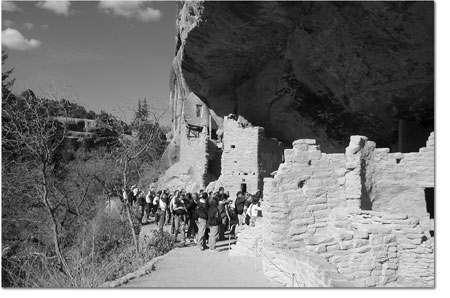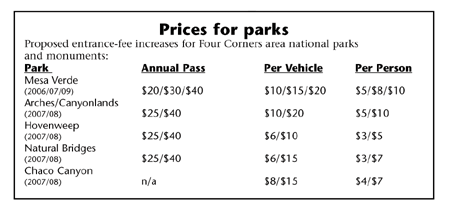| ||||
| The growing price of national parks Rates at Mesa Verde and other parks to double in coming years SideStory: Downward slide: Visitation declines as national park rates climb
by Missy Votel The cost of visiting America’s treasures is going up. A restructuring of park fees being implemented this summer by the National Park Service could mean increases of as much as 100 percent for the nation’s parks by 2009. The move is meant to streamline the park system’s fee structure, which currently is all over the board, Park Service officials say. However, public interest groups still reeling from the affects of 1996’s Fee Demo, say the increases will only price more people out of the parks. “The national parks are becoming unaffordable,” said Kitty Benzar, of the Western Slope No Fee Coalition. “Soon, the average family won’t be able to afford to go.” The new fees, which have been in the works for years as part of the Federal Lands Recreation Act, will affect 87 of the Park Service’s 391 parks, monuments and historical sites. Regionally, the rate hikes are planned for Mesa Verde National Park; Chaco Canyon National Historic Park in New Mexico; Arches and Canyonlands national parks and Natural Bridges National Monument in southeast Utah; Hovenweep National Monument in Southwest Colorado; and the Black Canyon of the Gunnison National Park, among others. The re-structuring, which is being spread out over three summers, is designed to make park fees more uniform, according to Park Service spokesman David Barna. “What we had was a mish mash of fees,” Barna said from Washington, D.C., on Monday. “We had a consulting firm look at the fees, and they suggested we go to a tier-structure, depending on size and other factors.” Barna said parks will be separated into three tiers of rates, with prices being adjusted periodically for inflation. Barna noted that prior to 1996, fees at many parks hadn’t increased for several decades, and since the implementation of Fee Demo, few parks have raised their rates. He also noted that the new fees will still be a bargain compared to other recreational diversions. Furthermore, the parks will be allowed to keep up to 80 percent of the fees, which will go toward park improvements. “The tradeoff is that the money collected in a park stays in the park and goes toward enhancing the visitors’ experience with things like restrooms, trails, accommodations and educational programs,” he said. The new source of funds will allow park superintendents to make improvements without going through the cumbersome federal budget process. “For many superintendents, it creates a discretionary fund for them to do projects that don’t require those several levels of approval,” he said. Furthermore, Barna pointed out that anyone who pays taxes supports the national park system, whether that person visits the parks or not. The rate increase is just an equitable way to have those who use the parks foot their part of the bill. “For example, RVers who go to a park and camp for a month are putting pressure on that park’s facilities, so maybe they should pay more,” he said. “We all pay to preserve the parks, but why should we subsidize others? The people who visit the parks should be asked to pay more.” Barna said the fee restructuring was not announced on a national level because they were merely “proposed” fees, with the final decision being left up to individual park superintendents and communities. Superintendents can appeal to the National Parks Service to rescind the fees if there is enough public opposition. One such area is Yosemite, where there has been an outcry over the planned increases for 2008. Locally, public opposition has been limited, say park managers.
“We put out a press release last year and haven’t heard anything,” said Mesa Verde spokeswoman Tessy Shirakawa. Mesa Verde will see an increase this summer as well as in 2009, with the price of an annual pass and the per-vehicle rate ultimately doubling. However, the new fee will only be in effect during the summer months, from Memorial Day through Labor Day, once the Wetherill Mesa Road opens. Shirakawa said the first set of rate hikes were set to go into effect this Memorial Day but have been put off because the Wetherill Road is closed for repairs. Once the road opens, tentatively in late June, the increases will go into effect. Shirakawa said it there has not been an increase in entrance fees at the park in several years, yet the cost of repairs and doing business keeps going up. With the fees, the park will be able to address a backlog in maintenance, she said. At the Park Service’s Southeast Utah Group, which includes Arches, Canyonlands, Natural Bridges and Hovenweep, increases are set to take place in 2008. According to Natural Bridges Superintendent Coralee Hays, public notice was given in January of this year and reactions were mixed. “Some felt it was appropriate and others were fearful it will price people out of the parks,” she said. She also said there was special concern from the cycling community, objecting to the doubling of the per-person fee despite the fact they weren’t using motorized vehicles in the parks. However, she said ultimately, the decision was made to raise the fees in one fell swoop beginning in January 2008. “It was more palatable to do it once rather than in increments,” she said. An annual “Local Level Pass” also will be available for all four parks for $40. Hays said by pooling funds between the parks, money will go further than if each park was operating individually. “Arches collects a sizeable amount of fees but all the parks have benefited,” she said. “There’s been extensive trail work, upgrades to restrooms and campgrounds. People can walk in and see a difference in the accommodations because of the fees.” However, Benzar, with the Western Slope No Fee Coalition, contends that such upgrades are neither merited nor wanted. She said the park improvements are merely another step in the “Disneyification” of the nation’s parks. “They’re treating the national parks like a commodity,” she said. “In some cases, they are ending up with more money than they need and building things no one wants.” For example, she points to construction of a multimillion-dollar visitors center at Cedar Mesa, Utah. “People go to Cedar Mesa to hike down into the canyons, nobody wanted a visitor’s center,” she said. Benzar also believes that the news of the fee increase was trickled out by design so as to avoid public uproar. However, now that news is getting out, with talk of a congressional hearing on the topic, the plan has backfired. “It’s not going down well with the public,” she said. “It’s coming back to bite (the Park Service).” Benzar said what her group would like to see is the reinstatement of the $50 National Parks Pass, which was discontinued this year in favor of the $80 America the Beautiful pass, which gains access to all national parks and Forest Service lands. “Eighty dollars is a lot of money,” she said. Furthermore, Benzar said she rejects the notion that the parks even need the money. “I don’t buy that argument, there’s plenty of money in the federal budget,” she said. However, if things stay on their present course, she said that may not be the case for long. “Pretty soon, no one’s going to care about preserving the parks because no one’s going to be visiting them because they can’t afford to.”
|



